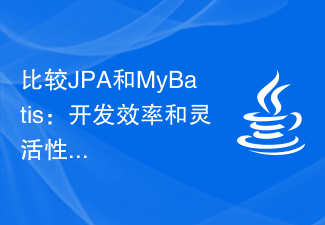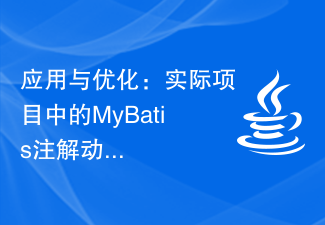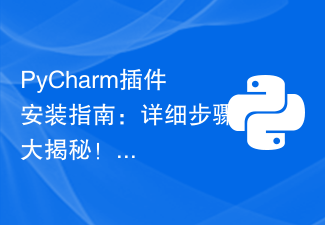 Backend Development
Backend Development PHP Tutorial
PHP Tutorial Mastering the readability of your PHP code: The art of PHPDoc documentation
Mastering the readability of your PHP code: The art of PHPDoc documentationphp editor Apple takes you to explore the key to PHP code readability: PHPDoc document. As a PHP programmer, writing clear and understandable documentation is crucial. PHPDoc documentation can not only improve the maintainability of the code, but also make team collaboration more efficient. This article will delve into how to use PHPDoc document specifications to optimize code comments, improve code quality, and make your PHP code more readable and understandable.
To ensure documentation consistency and accuracy, please follow the PHPDoc standard. Use /** and */ tags in comment blocks and specify document labels starting with @ symbols. For example:
/**
* 计算两个数的总和
*
* @param int $a 第一个数字
* @param int $b 第二个数字
*
* @return int 总和
*/
function sum(int $a, int $b): int
{
return $a + $b;
}
Describe functions and methods
Clearly and accurately describe the purpose of functions and methods. Includes parameters, return values, and potential exceptions. For example:
/**
* 将字符串转换为 html 实体
*
* @param string $string 要转换的字符串
*
* @return string 转换后的 HTML 实体字符串
*/
function htmlEntities(string $string): string
{
return htmlspecialchars($string);
}
Specify parameter type and default value
Use type annotations to specify parameter types for functions and methods. Default values can also be specified to handle optional parameters. For example:
/**
* 在数组中搜索值
*
* @param array $array 要搜索的数组
* @param mixed $value 要搜索的值
* @param bool $strict [可选] 是否执行严格比较(默认 false)
*
* @return int|null 值在数组中的索引(如果找到),否则返回 null
*/
function arraySearch(array $array, mixed $value, bool $strict = false): ?int
{
return array_search($value, $array, $strict);
}
Record return value
Use the @return tag to record the return value type of functions and methods. If the function has no return value, use void. For example:
/**
* 删除数组中的重复值
*
* @param array $array 要处理的数组
*
* @return array 去除重复值后的数组
*/
function arrayUnique(array $array): array
{
return array_unique($array);
}
Handling exceptions
Use the @throws tag to record exceptions that may be thrown by functions and methods. Includes exception classes and exception messages. For example:
/**
* 打开文件并读取其内容
*
* @param string $filename 文件名
*
* @return string 文件内容
*
* @throws RuntimeException 如果文件不存在或无法打开
*/
function readFile(string $filename): string
{
if (!file_exists($filename)) {
throw new RuntimeException("File not found");
}
$content = file_get_contents($filename);
if ($content === false) {
throw new RuntimeException("Unable to open file");
}
return $content;
}
Record modification history
Use the @since tag to record the introduced versions of functions and methods. This helps track the evolution of your code and avoid potential problems. For example:
/**
* 计算用户的平均年龄
*
* @param array $users 用户数组
*
* @return float 平均年龄
*
* @since php 8.0
*/
function averageAge(array $users): float
{
// 代码...
}
Generate documentation
Use tools such as PHPDocumentor to convert PHPDoc comments into HTML or other readable formats. This allows you to produce clean and organized documentation, improving code accessibility and reusability.
in conclusion
By adopting the best practices of PHPDoc documentation, you can greatly improve the readability, maintainability, and scalability of your PHP code. Clear, concise, and informative documentation makes collaboration easy, reduces maintenance costs, and improves the overall quality of the software. Following the PHPDoc standard, describing functions and methods, specifying parameter types, logging return values and exceptions, and tracking modification history will make your PHP code easier to understand and maintain.
The above is the detailed content of Mastering the readability of your PHP code: The art of PHPDoc documentation. For more information, please follow other related articles on the PHP Chinese website!
 PyCharm主题推荐:优雅的代码,从优秀的主题开始Feb 21, 2024 pm 04:27 PM
PyCharm主题推荐:优雅的代码,从优秀的主题开始Feb 21, 2024 pm 04:27 PM在编程的世界里,一个优秀的开发工具是程序员们必不可少的良师益友。PyCharm作为一款功能强大的Python集成开发环境,在市场上享有极高的声誉。它提供了丰富的功能,包括代码自动补全、调试器、版本控制工具等,帮助开发者提高开发效率,优化代码质量。然而,作为一个开发工具,PyCharm的界面和主题设计也是至关重要的。一个舒适、美观的界面可以让开发者在编写代码时
 将结构转换为 CSV 字符串Feb 09, 2024 pm 03:15 PM
将结构转换为 CSV 字符串Feb 09, 2024 pm 03:15 PM我有一个在数据库响应后被扫描的结构,如下所示。每个字段都是相同的len()。我想采用这个结构并生成一个csv分隔字符串/packagemainimport"fmt"typedatastruct{id[]stringcol1[]float64col2[]float64}funcmain(){d:=&data{id:[]string{"id_1","id_1","id_1","id_1"},
 命名Java变量时使用中文的优点和缺点Feb 18, 2024 am 10:14 AM
命名Java变量时使用中文的优点和缺点Feb 18, 2024 am 10:14 AM使用中文命名Java变量的优缺点在Java编程中,我们通常使用英文来命名变量、方法和类等标识符。然而,有时候我们也可以考虑使用中文作为标识符的一部分。本文将探讨使用中文命名Java变量的优缺点,并给出一些具体的代码示例。优点一:提高代码可读性使用中文命名Java变量可以使代码更易理解和阅读。毕竟,我们的大脑对于中文的理解和识别要比英文更为自然和流畅。对于非英
 解释Python是一种解释型语言的原因Sep 17, 2023 pm 10:41 PM
解释Python是一种解释型语言的原因Sep 17, 2023 pm 10:41 PMPython是一种通用解释型、交互式、面向对象的高级编程语言。Python在运行时由解释器进行处理。在执行程序之前不需要编译程序。这与PERL和PHP类似。执行步骤Step1-Python源代码由编码器编写。文件扩展名:.py第2步-编码器编写的Python源代码被编译为Python字节码。在此过程中,将创建一个扩展名为.pyc的文件。步骤3-虚拟机执行.pyc扩展文件。考虑虚拟机是Python的运行时引擎。这是Python程序运行的地方。因此,Python解释器包含了程序编译的过程,程序编译为
 比较JPA和MyBatis:开发效率和灵活性的对比Feb 20, 2024 am 09:54 AM
比较JPA和MyBatis:开发效率和灵活性的对比Feb 20, 2024 am 09:54 AMJPA和MyBatis:开发效率和灵活性的较量,需要具体代码示例引言:在现代软件开发领域,数据持久化层是一个至关重要的组成部分。为了提高开发效率和灵活性,开发者常常需要选择一个适合项目需求的ORM(对象关系映射)框架。JPA(Java持久化API)和MyBatis是目前广泛使用的两个框架,具备各自的优势和特点。本文将对比这两个框架的开发效率和灵活性,并提供
 应用与优化:实际项目中的MyBatis注解动态SQLFeb 19, 2024 am 09:55 AM
应用与优化:实际项目中的MyBatis注解动态SQLFeb 19, 2024 am 09:55 AMMyBatis注解动态SQL在实际项目中的应用与优化引言:MyBatis是一款优秀的持久层框架,它提供了多种SQL映射的方式,包括XML配置文件和注解。其中注解动态SQL是MyBatis的一项强大的功能,可以在运行时根据条件动态生成SQL语句,适用于处理复杂的业务逻辑。本文将介绍MyBatis注解动态SQL在实际项目中的应用,同时分享一些优化技巧与代码示例。
 PyCharm插件安装指南:详细步骤大揭秘!Feb 22, 2024 am 09:30 AM
PyCharm插件安装指南:详细步骤大揭秘!Feb 22, 2024 am 09:30 AMPyCharm插件安装指南:详细步骤大揭秘!PyCharm是一款功能强大的Python集成开发环境,它的灵活性和可扩展性使得用户可以根据自己的需求安装各种插件来增强开发体验。本文将详细介绍如何在PyCharm中安装插件,以及常用插件的安装步骤和示例代码。一、PyCharm插件安装步骤:打开PyCharm并进入File->Settings菜单;在Se
 提高代码可读性:Python常见的变量命名规则解读Jan 20, 2024 am 08:01 AM
提高代码可读性:Python常见的变量命名规则解读Jan 20, 2024 am 08:01 AM掌握Python中常见的变量命名规则,提升代码可读性,需要具体代码示例Python作为一门简洁而强大的编程语言,其代码可读性十分重要。变量是代码中最基本的元素之一,良好的变量命名规则可以帮助开发者更好地理解和阅读代码。本文将介绍Python中常见的变量命名规则,并提供具体的代码示例,帮助读者掌握如何提升代码的可读性。一、变量命名规则使用有意义的变量名:变量名


Hot AI Tools

Undresser.AI Undress
AI-powered app for creating realistic nude photos

AI Clothes Remover
Online AI tool for removing clothes from photos.

Undress AI Tool
Undress images for free

Clothoff.io
AI clothes remover

AI Hentai Generator
Generate AI Hentai for free.

Hot Article

Hot Tools

SecLists
SecLists is the ultimate security tester's companion. It is a collection of various types of lists that are frequently used during security assessments, all in one place. SecLists helps make security testing more efficient and productive by conveniently providing all the lists a security tester might need. List types include usernames, passwords, URLs, fuzzing payloads, sensitive data patterns, web shells, and more. The tester can simply pull this repository onto a new test machine and he will have access to every type of list he needs.

MinGW - Minimalist GNU for Windows
This project is in the process of being migrated to osdn.net/projects/mingw, you can continue to follow us there. MinGW: A native Windows port of the GNU Compiler Collection (GCC), freely distributable import libraries and header files for building native Windows applications; includes extensions to the MSVC runtime to support C99 functionality. All MinGW software can run on 64-bit Windows platforms.

SublimeText3 Mac version
God-level code editing software (SublimeText3)

SAP NetWeaver Server Adapter for Eclipse
Integrate Eclipse with SAP NetWeaver application server.

Zend Studio 13.0.1
Powerful PHP integrated development environment





